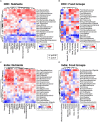Different Gut Microbial Profiles in Sub-Saharan African and South Asian Women of Childbearing Age Are Primarily Associated With Dietary Intakes
- PMID: 31474951
- PMCID: PMC6702451
- DOI: 10.3389/fmicb.2019.01848
Different Gut Microbial Profiles in Sub-Saharan African and South Asian Women of Childbearing Age Are Primarily Associated With Dietary Intakes
Abstract
Background: To compare and characterize the gut microbiota in women of childbearing age from sub-Saharan Africa (the Democratic Republic of the Congo, DRC) and South Asia (India), in relation to dietary intakes.
Methods: Women of childbearing age were recruited from rural DRC and India as part of the Women First (WF) preconception maternal nutrition trial. Findings presented include fecal 16S rRNA gene-based profiling of women in the WF trial from samples obtained at the time of randomization, prior to initiation of nutrition intervention and to conception.
Results: Stool samples were collected from 217 women (DRC n = 117; India n = 100). Alpha diversity of the gut microbiota was higher in DRC than in India (Chao1: 91 ± 11 vs. 82 ± 12, P = 6.58E-07). The gut microbial community structure was not significantly affected by any demographical or environmental variables, such as maternal BMI, education, and water source. Prevotella, Succinivibrio, and Roseburia were at relatively high abundance without differences between sites. Bifidobacterium was higher in India (4.95 ± 1.0%) than DRC (0.3 ± 0.1%; P = 2.71E-27), as was Lactobacillus (DRC: 0.2 ± 0.0%; India: 1.2 ± 0.1%; P = 2.39E-13) and Faecalibacterium (DRC: 6.0 ± 1.7%; India: 8.4 ± 2.9%; P = 6.51E-7). Ruminococcus was higher in DRC (2.3 ± 0.7%) than in India (1.8 ± 0.4%; P = 3.24E-5) and was positively associated with consumption of flesh foods. Succinivibrio was positively associated with dairy intake in India and fish/insects in DRC. Faecalibacterium was positively associated with vitamin A-rich fruits and vegetables. Overall, these observations were consistent with India being primarily vegetarian with regular fermented dairy consumption and DRC regularly consuming animal-flesh foods.
Conclusion: Consumption of animal-flesh foods and fermented dairy foods were independently associated with the gut microbiota while demographic variables were not, suggesting that diet may have a stronger association with microbiota than demographic characteristics.
Keywords: Democratic Republic of the Congo; India; Women; diet; microbiota.
Figures




Similar articles
-
Longitudinal Reduction in Diversity of Maternal Gut Microbiota During Pregnancy Is Observed in Multiple Low-Resource Settings: Results From the Women First Trial.Front Microbiol. 2022 Aug 1;13:823757. doi: 10.3389/fmicb.2022.823757. eCollection 2022. Front Microbiol. 2022. PMID: 35979501 Free PMC article.
-
Association of dietary type with fecal microbiota in vegetarians and omnivores in Slovenia.Eur J Nutr. 2014 Jun;53(4):1051-64. doi: 10.1007/s00394-013-0607-6. Epub 2013 Oct 31. Eur J Nutr. 2014. PMID: 24173964
-
Anthropometric indices for non-pregnant women of childbearing age differ widely among four low-middle income populations.BMC Public Health. 2017 Jul 24;18(1):45. doi: 10.1186/s12889-017-4509-z. BMC Public Health. 2017. PMID: 28738791 Free PMC article.
-
Diet, nutrients and the microbiome.Prog Mol Biol Transl Sci. 2020;171:237-263. doi: 10.1016/bs.pmbts.2020.04.006. Epub 2020 Apr 25. Prog Mol Biol Transl Sci. 2020. PMID: 32475524 Review.
-
Not just minor wild edible forest products: consumption of pteridophytes in sub-Saharan Africa.J Ethnobiol Ethnomed. 2014 Dec 22;10:78. doi: 10.1186/1746-4269-10-78. J Ethnobiol Ethnomed. 2014. PMID: 25534561 Free PMC article. Review.
Cited by
-
Age-related compositional and functional changes in the adult and breastfed buffalo rumen microbiome.Front Microbiol. 2024 May 30;15:1342804. doi: 10.3389/fmicb.2024.1342804. eCollection 2024. Front Microbiol. 2024. PMID: 38881655 Free PMC article.
-
Longitudinal Study of Oral Microbiome Variation in Twins.Sci Rep. 2020 May 14;10(1):7954. doi: 10.1038/s41598-020-64747-1. Sci Rep. 2020. PMID: 32409670 Free PMC article.
-
Geographical separation and ethnic origin influence the human gut microbial composition: a meta-analysis from a Malaysian perspective.Microb Genom. 2021 Aug;7(8):000619. doi: 10.1099/mgen.0.000619. Microb Genom. 2021. PMID: 34463609 Free PMC article.
-
Gut microbiota and other factors associated with increased T cell regulation in HIV-exposed uninfected infants.Front Immunol. 2025 Mar 3;16:1533003. doi: 10.3389/fimmu.2025.1533003. eCollection 2025. Front Immunol. 2025. PMID: 40098966 Free PMC article.
-
Health Impact and Therapeutic Manipulation of the Gut Microbiome.High Throughput. 2020 Jul 29;9(3):17. doi: 10.3390/ht9030017. High Throughput. 2020. PMID: 32751130 Free PMC article. Review.
References
-
- De Filippo C., Cavalieri D., Di Paola M., Ramazzotti M., Poullet J. B., Massart S., et al. (2010). Impact of diet in shaping gut microbiota revealed by a comparative study in children from Europe and rural Africa. Proc. Natl. Acad. Sci. U.S.A. 107 14691–14696. 10.1073/pnas.1005963107 - DOI - PMC - PubMed
Grants and funding
LinkOut - more resources
Full Text Sources
Medical

